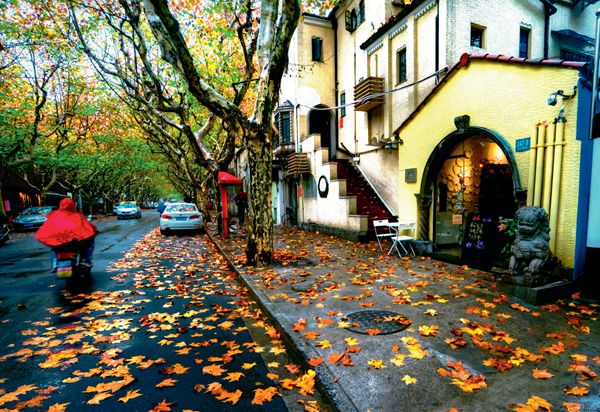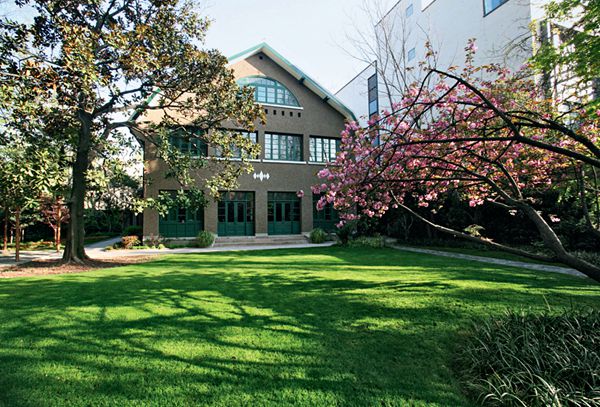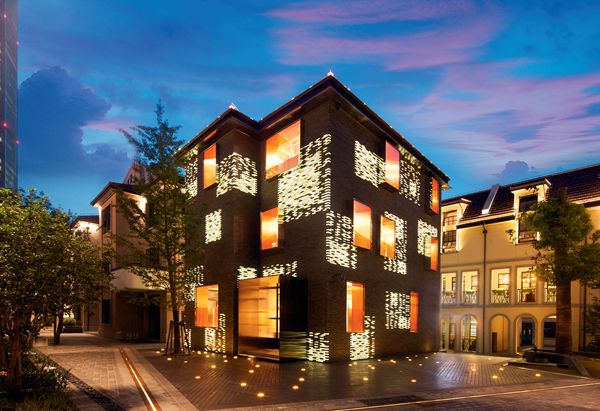Nostalgia in a Plane-tree-shaded Historic Area
By XU ZHI
IN the early 20th century plane trees, or sycamores, one of the world’s favorite street trees, stood throughout Shanghai’s French Concession. Today, as you walk through Xujiahui Park you can see the road where abundant plane trees shade the homes of historically prominent social figures.
This serene sanctuary, covering a 7.66 sq km area amid Shanghai’s busy commercial ethos, is known as Hengshan Road-Fuxing Road. Mostly situated in the Xuhui riverside area where stand around 30 well preserved historical streets, these old thoroughfares and their time-honored architectures evoke memories of past eras.
After its opening to the world as a commercial port 170 year ago, people of all walks experienced Shanghai’s vicissitudes, and left their essence in these old houses and alleys. The plane trees that offered shade from heat and rain witnessed the prosperity of the city in the 1930s and 1940s. Known as the “Paris of the East,” Shanghai was a blend of Western and Eastern cultures.
Old Western-style Buildings that Echo the City’s Memories
In many people’s eyes, local Shanghai culture embodies both the spirit and essence of this vibrant metropolis. Culture, the soul of a city, is largely imbued in its architectures reminiscent of past epochs.
Historical constructions on the Hengshan Road-Fuxing Road historic area are in diverse styles. Residents of these tasteful houses and gardens have helped to weave the city’s legends. Widely admired in their heyday, these buildings still hold great appeal for today’s younger generations.

The Hengshan Road-Fuxing Road historic area is both serene and elegant.
The triangular shaped Wukang Mansion, situated at the junction of Middle Huaihai Road and Wukang Road, is one of Shanghai’s most eye-catching landmarks. Designed by outstanding Hungarian architect László Hudec, and home to several dignitaries and famous film artistes it resembles a battle cruiser and was the city’s first veranda-style apartment.
Another ship-like building – the former residence of Soong Ching Ling (Mme. Sun Yat-sen) – is also located in this district. This German-style house, with its red roof and white walls, is surrounded by luxuriant camphor trees and plants, and emits an impression of calm yet brilliance. Artworks and paintings which friends from China and abroad presented to her are on display here, among them old photos of Dr. Sun Yat-sen and Soong Ching Ling. Exhibits also include a graceful qipao that Soong Ching Ling frequently wore.

Chinese modern literature master Ba Jin wrote his classic works in his residence which from the outside looks austere.
Ba Jin, a master of Chinese modern literature, lived in this district for some years. His former residence looks austere from the outside, but houses a vast collection of books. It was here that Ba Jin wrote his classic works, including a collection of essays.
Huang Xing, one of the main leaders of the 1911 Revolution, lived in this district for several months. During his short stay, Dr. Sun Yat-sen visited him twice to discuss revolutionary matters. Huang devoted his life to the country’s democratic progress. In recent years, his former residence has been refurbished and adapted into a tourist information and art center, themed on time-honored architectures. Today, culture and tourism, rather than politics and revolution, are the topics under discussion here.
Most Chinese people are familiar with the comic book hero Sanmao. Painter Zhang Leping created this character in his tranquil house on a secluded lane of this area. Having lived in Shanghai for nearly half a century, Zhang infused his comic images with his own observations of the city and his life there. It was through these images of Sanmao’s bitter childhood that people became aware of wartime’s stark social realities.
Side Streets: A Reason Why the City Inspires Such Love
Despite its location in a busy downtown area, the Hengshan Road-Fuxing Road historic area is both serene and elegant. The deeper you explore, the more you discover its charms.

The Hengshan Road-Fuxing Road historic area is both serene and elegant.
Among the side streets deep in this area, Wukang Road is most associated with legends of the city’s past. Previously known as Route Ferguson, this road holds the highest density of Shanghai’s old constructions.
Broad Hunan Road extends diagonally, aloof from the hustle and bustle. A stroll along it may help city dwellers rediscover their inner peace.
Dongping Road is the ideal place for lovers to cherish time together. Half of this 500-meter-long road is occupied by restaurants and recreation centers remodeled from the former residences of social celebrities. The other half, however, is still home to the local common people. This traditional, friendly neighborhood exemplifies the simple but contented daily life of its residents.
There is a well preserved short stone passage on the Taojiang Road. Just 200 meters in length, its flagstones bring back local people’s childhood memories. Lovers might also enjoy strolling here under its old-style lamps.
“Poetic” is perhaps the most appropriate description of Yongfu Road, an uplifting arcadia shaded by luxuriant plane trees.
Pub-goers should make a beeline for Hengshan Road – the city’s biggest bar street. Numerous pubs in old European-style buildings and graceful courtyards offer the best of Shanghai’s convivial nightlife.
Short and narrow, it takes less than 10 minutes to walk through Wuyuan Road. Its east side has the earthy feel of everyday people going about their business, while the west side gives an impression of grandeur, which has been frequently mentioned in the works of several famous writers.
Historic Area, a Microcosm of City Life
The Hengshan Road-Fuxing Road historic area cannot be described in a nutshell. It has absorbed the generosity and energy of a wide range of Chinese and overseas culture. A hub of innovative workshops, art studios, cafes, and historical architectures, the area merges new and old, traditional and contemporary, nostalgia and modernity. Traditional Shanghai-style life and culture intersects here perfectly with up-to-the-minute fashion. It is a place for retrospection while looking to the future. Moreover, it constitutes an archetype of sustainable urbanization. No matter how long one stays away, upon returning memories of this area are instantly rekindled.
XU ZHI is a freelance writer.
